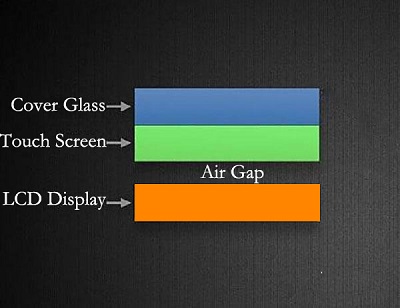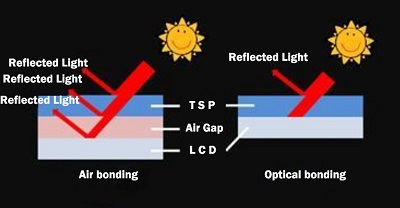Blog
In-Cell, On-Cell and OGS, three capacitive touch screen technologies
Structure of LCD touch screen
We can divide an LCD capacitive touch screen into three parts structurally. From top to bottom, there are cover glass, touch screen and LCD display.
Usually, touch screens and LCD displays are produced separately and glued together with air bonding technology. So, there will be an air gap between touch screen and LCD display.

Air bonding & Optical bonding technology for LCD touch screen
Air bonding is a simpler manufacturing technology with a high yield rate. Double-sided adhesive fixes touch screen and display panel around perimeter. However, there is an air gap between display panel and touch screen, which makes the whole display thicker. Reflected light and dust in air gap make screens less clear, too.
Optical bonding on the other hand, is to glue touch panel onto LCD screen with optical adhesive. Full-fit technology eliminates the air gap between layers. Less reflected light means better display. However, Optical bonding is an expensive technology. Now only a small number of customers with special needs choose this type of touch screen. As more and more end-users demand better LCD display, optical LCD touch screen will become mainstream.

Three technologies of capacitive touch screen display
In-Cell, On-Cell and OGS(One Glass Solution) are three new ways to create capacitive touch screen display.
In-Cell refers to embedding touch panel function into liquid crystal pixels, that is, embedding touch sensor function inside LCD screen. Traditional touch panel is no longer necessary. In-cell is an innovation of loading circuits onto liquid crystal. This kind of LCD is much thinner with better readability in sunlight.
On-Cell means embedding touch screen between color filter substrate and polarizer, in other words, equipping sensor on LCD panel. Although manufacture of on-cell screens is easier than In-Cell, there are still thickness and color uneven problems.
OGS technology is to fit touch screen and protective glass together. Inside of protective glass is ITO conductive layer. Coating and lithography are done directly on the glass. This makes touch screen thinner and cheaper. However, protective glass is usually tempered first, then coated, etched, and finally cut. Cutting tempered glass is difficult with low yield rate. Capillary cracks on the edge will weaken the cut glass.

Summary
Amongst the three types of capacitive touch screens, they have different pros & cons in following areas.
? Permeability: OGS is the best, followed by In-Cell and On-Cell.
? Thinness: In-Cell is the winner. OGS and On-Cell are next.
? Touch effect: OGS touch sensitivity is better than In-Cell & On-Cell.
? Production difficulty & cost: In-Cell and On-Cell are more difficult and costly than OGS.
If you have any questions about touch screens, please consult us. Topway with more than 25 years of experience of LCD display, will give you a satisfactory solution.
